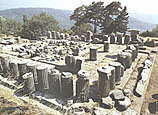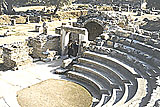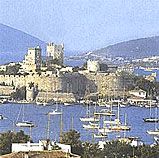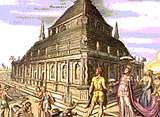|
The two communication giants Ericsson and Türkcell put their efforts together in order
to restore the Myndos Gate and the surrounding city walls. These walls which played an important role in the history
have been neglected for many years.
The Myndus gate is located by the old Gumbet road, near the Gumbet junction, next to the
Turkish cemetery at the western exit of the town.  see phototour see phototour
This project, which was made possible by the support of Ericsson and Turkcell, aims to restore
the ancient city wall of Bodrum, known in antiquity as Halikarnassos, with particular attention to Myndos Gate
and the Ottoman Tower, landscaping and lighting has made the walls accesible to the public. Restoration is an important
step in appreciating an preserving the heritage of this important historical site.
Included in this project were 7 km long city walls of Bodrum, The Myndos Gate and The Ottoman Tower west of Bodrum
Harbour. The first phase of the project started on 15 July 1998 with archaeological excavations and cleaning process
around north and south towers of Myndos Gate.
During the excavations, many stone blocks were found, marked and stored for future placements. Vaulted tombs from
the Hellenistic and Roman periods are found in the vicinity. The actual burial chambers of these tombs, almost
all opened by Newton in the last century, are under the vaulted sections. Terracota sarcophagi were found in the
tombs. The ditches that played an important role against the siege of Alexander the Great were marked and taken
under protection.
The first phase has successfully been completed in June 1999 and the second phase that includes the restoration
of the rest of the walls and the tower from Ottoman Era will commence in the very near future.
The city wall of ancient
Halikarnassos dates from 364 B.C. The 7 km long city wall surrounds the town from the west side
of the harbor to Goktepe. Castles at Salmakis to the west and Zephyrion to the east mark the junction of the city
wall and the harbor. Although no traces remain of Mylasa Gate, which opened to the east, large portions of Myndos
Gate survived intact. Myndos Gate was constructed of two monumental towers at either side
Built on the valley, the western part of the city wall was fortified with towers, these measuring approximately
7x8.5 me-ters at the base. One of the towers of the Myndus gate has come down to the present day in almost its
original height. The gate got its name from the antique city of Myndus, located on the extremity of the peninsula.
Today it is called Dikdiri.
Arrianus, who has given a detailed description of Alexander's siege of the town mentions that the gate was a Tripillion
(three-towered). Of the three towers, built with rectangular blocks of stones the one which once stood in the center
has corn-
pletely vanished. Arrianus also writes about the existence of a moat, 15 meters wide and 8 meters deep, in front
of gate. Alexander, arriving at Halicarnassus in the fall of 334 B.C., set up his headquarters at the spot called
Yoku~ba~i today. His first assault was upon the Mylasa gate of which no trace remains. The attack was repulsed
with difficulty by the satrap Oron-tobates and Memnon of Rhodes. A few days later Alexander, with part of his forc-es,
at~cked the Myndus gate but was again unsuccessful. He then constructed a wooden bridge over the moat and re-newed
the attack on the city. This time, the Macedonians made use of siege tow-ers. The Halicarnassians sallied out and
were able to burn down one of the towers and a hand to hand fight followed. The wooden bridge, unable to carry
the weight of the dead, collapsed, thus causing the death of still more soldiers from both sides. The fight turned
in favour of the Macedonians. The city panicked, and clos-ing the gates too early, caused the death of many of
their fellow men who got trapped outside. Having suffered heavy casualties, Orontobates and Memnon re-treated to
the two inner castles on the is-land and Salmacis, while sending some of their soldiers on ships to Cos. Alexander
ordered the city walls and the city itself to be torn down, with the exception of the palace and the Maussolleion.
Not waitin9 for the surrender of the two castles, he left a force of 3000 infantry and 200 cavalry under the command
of Ptolemaios, and marched on to Phrygia.
Although being short of water, the Bodrum peninsula has been inhabited throughout the centruies. Houses of mountain
villages along the Bodrum- Turgut Reis highway look like pieces of the traditional Turkish white cheese. The white-washed
houses of Bodrum and the surroundings, rising side by side with their flat roofs and beautifully proportioned win-dows,
are reflections of the Mediterranean architecture. Garden walls facing narrow streets are decorated with flowers
in a multitude of colours.
Bodrum houses are divided into three main types: The "Musandira", "Chios" and the "Tower"
house. Of these, the tower-house is the oldest type. In Bodrum, any house which might resemble a tower is called
a tower-house however, only 13 original tower-houses remain today. Tow-er-houses, which were built for reasons
of defence, have square or almost square ground plans. The entrance of the house, which is reached by going up
a wooden staircase, opens on the first floor. In days of the past, it is said, these houses were entered by bridges.
A good example for the tower-house can be seen in the village of Ortakent. The toilet is built outside, ad-joining
the house. The ground floor is used as a stable and the middle and top floors are reached with a wooden stair-case.
Stylized embreasures can be seen built on the roofs of Ortakent. The toilet is built outside, adjoining the house.
Chios-type houses have rectangular plans. A room is located on each side of the entrance, which in general is on
the eastern fa§ade. The fireplace is built in one of these rooms. The toilet, kitchen and water-well are found
in the garden of the house. This is a good example for the life style which is concentrated on out-door-living
because of the climate.
The Musandira-type is the house built by those who cultivate the land. The en-trance to the house is on the long
fa§ade. The fireplace inside is built on the shod wall. This type of house has two sections:
The lower and the upper house. The liv-ing area, called "musandira" is reached wtih a ladder situated
next to the entrance of the lower floor, which is used for stor-age purposes. Also, in these houses an apron floor
is built inside the upper house.
Water cisterns (gflmbet), scattered all over the area, supply the water demand of the region. The cisterns which
look like on the whole, consist of two sections: The domed roof and the part where the rain water, entering from
the holes at the base of the dome, collects.
Strabo mentions the existence of eight Lelegian cities on the peninsula. These were: Syangela, Pedasa, Side, Madhasa,
Uranium, Telmissus, Termera and Myn-dus, Except for Myndus and Syangela, which were located on the opposite ex-tremities
of the peninsula, the inhabitants of the other cities were forced to live in
Halicamassus during the reign of Maussollos. The actual Lelegian city of Myndus which Strabo mentions is not GQmt1~lt1k,
but Bozdag, 3 kilometres southeast of this village.
towers, one can see the castle's curtain wall at certain places. Outside the wall, to the southwest of the city,
can be seen a few rows of stones, these being the only remains of the Athena temple.
Around the VI. and V. centuries B.C. Pedasa was one of the major cities of the region, but later lost all its importance.
Located on the west side of Bodrum, this is one of the two entrances of the ancient Halicarnassus. It was part
of the towns wall
The gate is named after Myndos because it is facing the old place Myndos (Now Gümüslük). The regional
name is now 'Diktiri' or 'Dikduru', which means standing straight or upright, because it has survived more than
2.500 years.
According to Arrianus, who was describing this gate and and the stage of siege of Alexander the Great in 334, this
gate had originally three towers (that's why it was described as 'Tripollion'). It was also mentioned that in front
of the gate was a ditch of 8 meters depth and 15 meters long. The middle part of the gate is destroyed now totally
but ruins from the two other parts are still existing and made from huge and heavy square stones.
Tombs were found here and opened by Newton in the last century. They dated back to Hellenistic and Roman times
and were made from burned clay.
When Alexander the Great in the autumn of 334 BC came to Halikarnassos, he was having his headquater somewhere
around here. His first attack was towards the Milas gate, which is not more existing nowadays, but he could'nt
make it. On the Halicarnassus side were fighting the Persian generals Oronbates and Memnon from Rhodos. After a
couple of days he was trying it with the Myndos gate, again there was a lot of resistance. Then he was building
a wooden bridge over the 8 m. ditch, packed some of his Makedonian soldiers in wooden towers and carried them close
to the gate, but Halicarnassus people came out and tried to burn those towers and started fighting, but the bridge
collapsed after a while and there was a big panic on both side. Despite there were many of their own warriors outside
and killed, the gate was closed and Memnon and Oronbates went to the castle and the harbour and sailed to Kos.
Alexander the Great was conquering the town then and destroying the place all over, just the mausoleum he didn't
touch, after that he was going southwards to Phrygia.
Here is a wealth of information about http://www.ericsson.com.tr/ay
 Bodrum selbst, im
Altertum Bodrum selbst, im
Altertum  Halikarnassos
genannt, ist eine der bekanntesten antiken Staedte in diesem Raum, es wurde bereits 11. Jhrhdrt. vChr. gegründet
worden. Unter dem karischen Herrscher Halikarnassos
genannt, ist eine der bekanntesten antiken Staedte in diesem Raum, es wurde bereits 11. Jhrhdrt. vChr. gegründet
worden. Unter dem karischen Herrscher  Mausolos (377-353 v. Chr.) erlebte Halikarnassos seine Bütezeit, sein prachtvolles
Grab war eines der sieben Weltwunder. Im Mittelalter hatten die Johanniter von Rhodos hier einen Stützpunkt;
sie bauten das Kastell, benutzten dafür aber das Mausolos (377-353 v. Chr.) erlebte Halikarnassos seine Bütezeit, sein prachtvolles
Grab war eines der sieben Weltwunder. Im Mittelalter hatten die Johanniter von Rhodos hier einen Stützpunkt;
sie bauten das Kastell, benutzten dafür aber das  Mausoleum als Steinbruch. Mausoleum als Steinbruch.
Sehenswert sind außerdem das  Myndos Tor, (ebenfalls aus der Zeit der König Mausolos), jüngst freigelegt
von Ericsson und Türkcell, sowie das Myndos Tor, (ebenfalls aus der Zeit der König Mausolos), jüngst freigelegt
von Ericsson und Türkcell, sowie das  Amphi Theater, von dem man bei Sonnenuntergang den besten Blick auf Bodrum hat. Amphi Theater, von dem man bei Sonnenuntergang den besten Blick auf Bodrum hat.
Die nachfolgenden Stätten auf der Bodrum-Halbinsel bergen ein immenses Maß an antiker Geschichte, wurden
aber bis heute noch nicht ausgegraben. Daher liegen nur spärliche Angaben über diese antiken Plätze
vor.
 PEDASA (GÖKÇELER) PEDASA (GÖKÇELER)
Pedasa war eine lelegische Siedlung im Norden von Bodrum, (von Konacik zu erwandern) und besaß im 6. - 5.
Jh. v. Chr. einige Bedeutung, einige Historiker gehen davon aus, daß Pedasa größer und ebenfalls
bedeutender war als Halikarnassos. Die Stadt befand sich im Inneren einer Festung, deren Mauern durch Türme
verstärkt waren. Der als religiöses Zentrum bedeutende Athenatempel, lag außerhalb der Befestigungsmauern.
Die Stadt war von Grabanlagen umgeben. Hier bestattet zu sein galt als Ehre bei den Bewohnern.
 TELMESSOS/ TELMISSOS (GÜRECE) TELMESSOS/ TELMISSOS (GÜRECE)
Die hinter dem Dorf Gürece auf einem Hügel gelegene lelegische Siedlung, könnte das antike Telmissos
gewesen sein. Durch seinen Apollo Tempel und seine Weißsagungen berühmt geworden, galt es als wichtiges
religiöses Zentrum. Heute ziehen ein Turm auf dem Hügel und vereinzelte Gräber den Blick auf sich.
 TERMERA (ASPAT-ÇIFT KALE) TERMERA (ASPAT-ÇIFT KALE)
Antiken Schriftstellern zufolge befand sich Termera gegenüber der Insel Kos. Auf der, als Asarlik Hügel
bekannten Erhebung, befinden sich ausser Siedlungsüberresten auch die Ruinen einer Burg. Die Bevölkerung
wurde unter Mausolos nach Halikarnassos zwangsumgesiedelt.
 SYANGELA (ALA ZEYTIN) SYANGELA (ALA ZEYTIN)
Diese lelegische Siedlung ist von einer turmbestandenen Befestigungsmauer umgeben. Dort sind aus soliden Steinen
errichtete, für den Volksgebrauch bestimmte Gebäude, wie das Stadtrathaus, der Marktplatz und der Heroon-Tempel
zu sehen .
 MYNDOS (GÜMÜSLÜK) MYNDOS (GÜMÜSLÜK)
Ursprünglich befand sich die lelegische Siedlung Myndos auf dem Bozberg. Nach der Neugründung
durch Mausolos breitete sich das neue Myndos großflächig in Küstennähe aus. Die befestigte
Stadt besaß einen gutgeschützten Hafen. Die Ruine einer byzantinischen Kirche und die wellenumspülten
Reste eines Turmes sind noch sichtbar. 44 v.Chr. wurde Myndos von den Cäsarmördern Brutus und Cassius
als Stabsquartier benutzt.
 THIANGELA THIANGELA
Thiangela ist eine, von Befestigungsmauern umgebene lelegische Stadt. Unter Mausolos wurde die Bevölkerung
der umliegenden Siedlungen hier zwangsangesiedelt, die Stadt erhielt einen neuen rechteckigen, geordneten Stadtplan
und wurde ausgebaut.
 MADNASA MADNASA
Madnasa ist eine zwischen Türkbükü und Gölköy gelegene befestigte lelegische Siedlung.
 URANIUM (BURGAZKALE) URANIUM (BURGAZKALE)
Hier sind Befestigungsmauern und zwei Türme vorhanden.
 if
you have any suggestions or experiences, please drop
us a note if
you have any suggestions or experiences, please drop
us a note
Use Enterprise Translation Server to translate this page into: Spanish | French | Italian | Norwegian | Portuguese
 zurück
nach oben zurück
nach oben
|

|
|

|
|
 Zeustempel Labranda Zeustempel Labranda

|
|
|
|

|
|

|
|
 Iassos Iassos

|
|

|
|

Die Bodrum Postkarte
|
|

|
|

|
|

|
|
Landmark of Bodrum - the castle



|
|

|
|

|
|
Ieine weitere Version des Mausoleums von Halikarnassos


|
|

|
|
|
Free Downloads

|
|
|
|

|

|
|
all boats - all itineraries,
choose a gulet  from here
from here

|
|